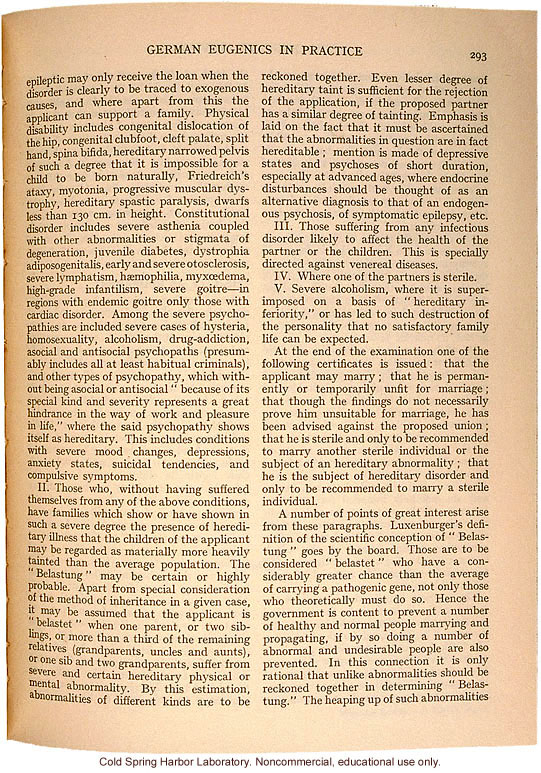German Eugenics In Practice 293
epileptic may only receive the loan when the disorder is clearly to be traced to exogenous causes, and where apart from this the applicant can support a family. Physical disability includes congenital dislocation of the hip, congenital clubfoot, cleft palate, split hand, spina bifida, hereditary narrowed pelvis of such a degree that it is impossible for a child to be born naturally. Friedrich's ataxy, myotonia, progressive muscular dystrophy, hereditary spastic paralysis, dwarfs less than 130 cm. in height. Constitutional diorder includes severe asthenia coupled with other abnormalities or stigmata of degeneration, juvenile diabetes, dystrophia adiposogenitalis, early and severe otosclerosis, severe lymphatism, haemophilia, myxoedema, high-grade infantilism, severe goitre - in regions with endemic goitre only those with cardiac disorder. Among the severe psychopathies are included severe cases of hysteria, homosexuality, alcoholism, drug-addiction, asocial and antisocial psychopaths, (presumably includes all at least habitual criminals), and other types of psychopathy, which without being asocial or antisocial "because of its special kind and severity represents a great hindrance in the way of work and pleasure in life," where the said psychopathy shows itself as hereditary. This includes conditions with severe mood changes, depressions, anxiety states, suicidal tendencies, and compulsive symptoms.
II. Those who, without having suffered themselves from any of the above conditions, have families which show or have shown in such a severe degree the presence of hereditary illness that the children of the applicant may be regarded as materially more heavily tainted than the average population. The "Belastung" may be certain or highly probable. Apart from special consideration of the method of inheritance in a given case, it may be assumed that the applicant is "belastet" when one parent, or two siblings, or more than a third of the remaining relatives (grandparents, uncles and aunts), or one sib and two grandparents, suffer from severe and certain hereditary physical or mental abnormality. By this estimation, abnormalities of different kinds are to be reckoned together. Even lesser degree of hereditary taint is sufficient for the rejection of the application, if the proposed partner has a similar degree of tainting. Emphasis is laid on the fact that it must be ascertained that the abnormalities in question are in fact hereditable; mention is made of depressive states and psychoses of short duration, especially at advanced ages, where endocrine disturbances should be thought of as an alternative diagnosis to that of an endogenous psychosis, of symptomatic epilepsy, etc.
III. Those suffering from any infectious disorder likely to affect the health of the partner of children. This is specially directed against venereal diseases.
IV. Where one of the partners is sterile.
V. Severe alcoholism, where it is super-imposed on a basis of "hereditary inferiority," or has had led to such destruction of the personality that no satisfactory family life can be expected.
At the end of the examination one of the following certificates is issued: that the applicant may marry; that he is permanently or temporarily unfit for marriage; that though the findings do not necessarily prove him unsuitable for marriage, he has been advised against the proposed union; that he is sterile and only to be recommended to marry another sterile individual or the subject of an hereditary abnormality; that he is the subject of hereditary disorder and only to be recommended to marry a sterile individual.
A number of points of great interest arise from these paragraphs. Luxenburger's definition of the scientific conception of "Belastung" goes by the board. Those are to be considered "belastet" who have a considerably greater chance than the average of carrying a pathogenic gene, not only those who theoretically must do so. Hence the government is content to prevent a number of healthy and normal people marrying and propagating, if by doing so the number of abnormal and undesirable people are also prevented. In this connection it is only rational that unlike abnormalities should be reckoned together in determining "Belastung." The heaping up of such abnormalities
[end]


